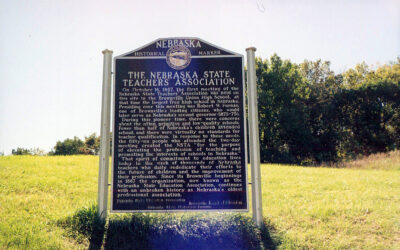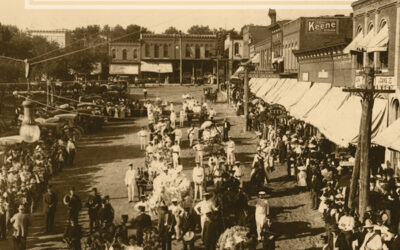Graduating from high school jeopardized your chance to teach in rural schools in the 1800s.
Sadie B. Smith was a Nebraska teacher in the late nineteenth century who had to balance being educated enough to teach but not “too” educated to be employable. What qualified as “too” educated?
A high school diploma.
Sadie’s letters to her future husband, Rollin A. Trail, cover a seventeen-year courtship from 1889 to 1906. They give readers a rich look into the life of a young, ambitious teacher in small-town Nebraska during a time when taxpayer-supported, public education on the frontier was in its infancy, and the idea that a woman might see teaching as her career instead of as a filler between middle school and marriage was unheard of. These letters are in our collections, and Rollin and Sadie’s daughter Rosalie Trail Fuller writes about them in the Winter 1977 and Fall 1979 editions of Nebraska History.
Sadie B. Smith was born December 24, 1873, to Oren Sylvester Smith and Sarah Frances Thompson Smith in a sod house north of Western in Saline County. She attended high school in Crete, and during her senior year she substituted at a rural elementary school in the area.
Friends told Sadie that graduating from high school jeopardized her chances to teach in rural schools. A high school diploma would designate her as “stuck up,” and she wouldn’t be able to connect or communicate well with her students and their parents. Prejudice against high school-educated teachers was so threatening that Sadie learned dressmaking as a back-up trade in case she couldn’t find employment at a school.
High school curriculum was a little different from what we expect from students today; Sadie studied Latin through Virgil, algebra, geometry, trigonometry, English literature, physics, and botany. Despite sentiments opposing highly-educated teachers, Sadie graduated high school in June 1891, when she was 17. After graduation, Sadie attended the county institute at Wilber to earn her teachers’ certificate. County superintendents oversaw these institutes, which helped instruct teachers before they took over their own school.
Sadie was hired for a two-month term at the Coplin Schoolat $25 per month. Later, she secured a position at another school at $30 per month for a two-month term. But even though the school found nothing wrong with her teaching, Sadie was not rehired. A local girl who had passed the teachers’ examination, but had no teaching experience and no high school diploma, underbid Sadie by $5 for the spring term. The older boys would be working in the field, so the school board thought the teaching would be easier and therefore should also be less expensive to taxpayers. Keeping order in the schoolroom was valued more than the quality of the curriculum or the instruction. The community also felt that the teacher’s pay should remain in the district and benefit a local girl. After all, most teachers were expected to teach only a term or two before getting married, and the salary would benefit her hope chest.

Sadie Smith and a group of her North Bend friends. L-R: Edith Stocking, Luella Owen, Sadie Smith, Cora Owen, May Dion, Rosalie Dion, and Mrs. Dion, 1898
As a result, Sadie moved to Colorado Springs with her father and stepmother. She went to the ranching country west of Colorado Springs, where she earned $45 a month to teach a summer term.
After two years of teaching in Colorado, Sadie returned to Nebraska, enrolled in the Peru State Normal School as a senior, and graduated in 1895 when she was 21. Sadie’s desire to learn so she could be a better teacher outweighed her concerns about being “overeducated.” She also attended the Normal School in Lincoln while she taught at Dunbar after her graduation from Peru State.
In September 1896, Saide went to North Bend in Dodge County to be a “high school assistant,” which meant she taught Latin, algebra, history, literature, botany, physical Geography, and grammar. After Sadie listed off her course load, she remarked to Rollin in a Sept. 13, 1896 letter, “Perhaps I shall have plenty of spare time, but I can’t see it now.”
Sadie’s letters reveal that problems that plagued teachers in 1896 are similar to those educators are facing today. North Bend didn’t even pay her when she first started. “I have just labored five months without one dollar’s pay,” she writes on February 7, 1897. “It is always just coming. Last reported, ‘we will have some money in, next week…’”
She writes in 1899 that her superintendent was making $1,000 a year to teach three classes, two of them with six students, along with his superintending duties. Sadie made $495 per year, and she taught seven classes, each class ranging from seventeen to fifty students. She writes, “…I grow unutterably weary looking over narratives and outlines and questions.” At this time, Sadie was also considered the high school’s principal. She writes that her superintendent “…had given me the title of principal and when I remonstrated with him he said, “Why that is what you are; you do the work of a principal and are entitled to the name.” If it amounted to anything I should feel elated, but it doesn’t so I am no larger than before…”
Her low salary is even more remarkable when you consider that Sadie literally put out fires when she was teaching: “When I walked into the high school room a lurid glare met my sight. The red flames were leaping past the second floor in the ventilation shaft, and without stopping to reason as to what I was doing, I rushed down and started those children who had arrived [to go] for help. Meanwhile a big boy and I pumped water and poured on the fire. Some men arrived, and with some six or eight buckets of water put it out.”
But Sadie loved teaching. She writes on Oct. 3, 1897: “It is quite different to go back to a school the second year, where there is a chance to profit from your first year’s blunders, than to start in a new place, where you can’t profit by any former experience. Each year I teach I like the work better.” She also loved her fellow teachers, “Some of the other teachers take dinner here and we have jolly times I tell you. We make enough noise to be heard several blocks at times. It seems to be the end and aim of each one in the crowd to get a joke on me, and I spend my time getting even and generally succeed.”
After she had been at North Bend for nearly four years, Sadie began considering her next career move. She tells Rollin, “The folks are very anxious for me to rest a year and spent time with them. I’d like this very much, but how utterly useless for me to think of wasting a year at my time of life. It is a very short time when we use every moment. I can’t see how people get anywhere at all who waste their time.”
Sadie’s desire to teach did not let her take a year off. She accepted a position as principal of Holdrege High School (a real principal position, not just a title since she was doing all the work anyway) in the spring of 1900, and she remained there until 1905. She earned $65 a month at Holdrege. On March 7, 1906, when she was 32, she and Rollin married. They traveled with his job for the railroad and had three children – one of whom was born in an apple-picker’s shack in Washington state. The family eventually returned to Otoe County in Nebraska. Rollin died on December 15, 1916, making Sadie a widow at 42. She returned to teaching to support her family, and worked as a principal and superintendent as well as a teacher. She died in Lincoln after a long illness on May 24, 1942, when she was 68.




